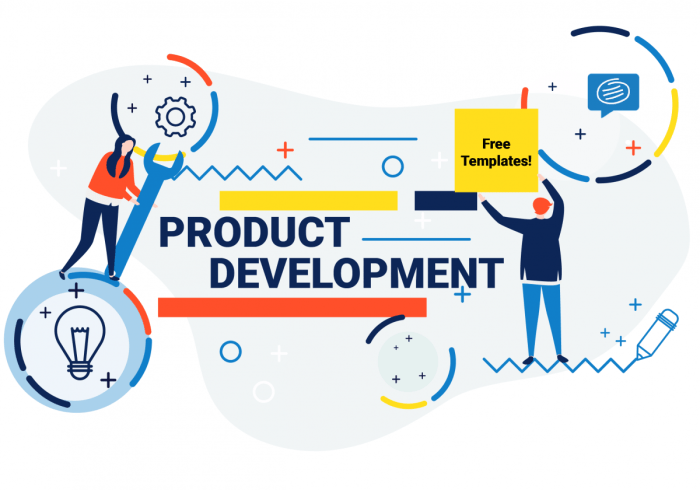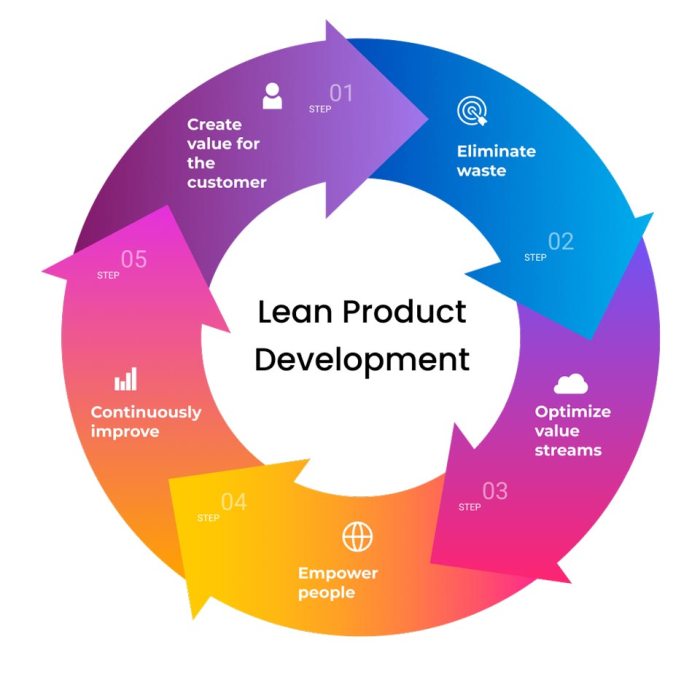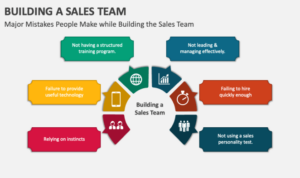Product development sets the stage for innovation and growth in business. From market research to prototyping and testing, each phase plays a crucial role in creating successful products that meet consumer needs and demands.
Let’s dive into the intricate process of developing products that not only captivate but also deliver value to customers in a competitive market landscape.
Overview of Product Development
Product development is the process of creating a new product or improving an existing one to meet the needs and wants of customers. It involves research, design, testing, and launching the product into the market.
Importance of Product Development
Product development is crucial for business growth as it allows companies to stay competitive, attract new customers, and increase revenue. By continuously innovating and improving products, businesses can adapt to changing market trends and customer preferences.
Key Stages in Product Development
- 1. Idea Generation: This stage involves brainstorming and coming up with new product ideas based on market research and customer feedback.
- 2. Concept Development and Testing: Once an idea is selected, a concept is developed and tested with potential customers to gather feedback and make necessary adjustments.
- 3. Design and Engineering: The product is then designed and engineered, taking into consideration factors such as materials, manufacturing processes, and cost.
- 4. Prototype Development: A prototype of the product is created for further testing and refinement before mass production.
- 5. Testing and Validation: The product undergoes rigorous testing to ensure it meets quality standards and is safe for use.
- 6. Launch and Commercialization: The final product is launched into the market with a marketing strategy to promote sales and generate revenue.
Market Research: Product Development

Market research is a key component in the product development process as it helps businesses understand the needs and preferences of their target audience. By gathering data and insights from market research, companies can make informed decisions about their product development strategies.
Methods for Conducting Market Research
- Surveys: Companies can create online or in-person surveys to gather feedback from potential customers about their preferences, behaviors, and opinions.
- Focus Groups: Bringing together a small group of individuals to discuss and provide feedback on a product or concept can offer valuable insights for product development.
- Interviews: Conducting one-on-one interviews with target customers can provide in-depth insights into their needs and preferences.
- Observational Research: By observing how customers interact with products in real-life settings, businesses can gather valuable data on user behavior.
Influence of Market Research on Product Development Decisions
Market research plays a crucial role in shaping product development decisions. For example, if a company conducts surveys and finds that customers prefer eco-friendly products, they may decide to focus on developing sustainable options. Similarly, if focus groups express a need for more user-friendly features, a company may prioritize improving the user experience in their product design. Overall, market research helps businesses align their product development efforts with the preferences and needs of their target audience.
Idea Generation
Generating new product ideas is a crucial step in the product development process. It involves coming up with innovative concepts that can meet the needs and desires of consumers.
Brainstorming
One of the most common techniques for idea generation is brainstorming. This involves a group of individuals coming together to share and build upon each other’s ideas in a creative and open-minded environment.
- Encourages diverse perspectives
- Promotes out-of-the-box thinking
- Allows for rapid idea generation
Market Research
Another technique for generating new product ideas is conducting thorough market research. By analyzing market trends, consumer behavior, and competitors, businesses can identify gaps in the market and opportunities for innovation.
- Helps in understanding consumer needs
- Identifies emerging trends
- Provides insights into competitors’ weaknesses
Importance of Creativity
Creativity plays a vital role in the idea generation phase as it fuels innovation and helps in developing unique and appealing product concepts. Thinking outside the box and challenging conventional ideas can lead to breakthrough innovations.
“Creativity is intelligence having fun.” – Albert Einstein
Real-World Examples
Many successful product ideas have been born out of innovative thinking. For example, the iPhone revolutionized the smartphone industry by combining a phone, music player, and internet device into one compact device. Another example is Airbnb, which disrupted the hospitality industry by connecting travelers with local hosts for unique accommodation experiences.
Prototyping and Testing

Prototyping and testing play a crucial role in the product development process. Prototyping involves creating a preliminary version of the product to test its functionality, design, and feasibility before moving on to full-scale production.
The Prototyping Process
Prototyping typically involves developing a scaled-down version of the product using materials that closely resemble the final product. This allows designers and engineers to identify any potential issues, make necessary adjustments, and ensure that the product meets the desired specifications.
- Prototyping helps in visualizing the final product and identifying any design flaws early on.
- It allows for testing different features and functionalities to ensure they meet user requirements.
- Prototypes can be used to gather feedback from stakeholders and potential customers for further refinement.
Importance of Testing Prototypes
Before moving into full-scale production, it is essential to test prototypes rigorously. Testing prototypes allows for identifying any defects, weaknesses, or areas of improvement that need to be addressed before mass production.
- Testing helps in ensuring that the product meets quality standards and regulatory requirements.
- It allows for evaluating the performance, durability, and usability of the product in real-world conditions.
- Identifying and fixing issues at the prototyping stage can save time and costs in the long run.
Influence of Feedback on Product Refinement
Feedback from testing prototypes is invaluable in refining the product and making it more market-ready. This feedback provides insights into user preferences, pain points, and areas for improvement that may not have been apparent during the design phase.
- Feedback helps in making informed decisions about design changes and enhancements based on user input.
- It allows for iterative improvements, ensuring that the final product meets customer expectations and demands.
- Incorporating feedback from testing leads to a more successful product launch and better customer satisfaction.
Design and Engineering
When it comes to product development, the collaboration between design and engineering teams plays a crucial role in creating successful and innovative products. Designers focus on the aesthetic appeal and user experience, while engineers ensure the functionality and feasibility of the product. Finding the balance between these two aspects is essential for creating a product that not only looks good but also works effectively.
Synergy Between Design and Engineering, Product development
- One prime example of successful synergy between design and engineering is the iPhone. Apple’s design team created a sleek and minimalist look, while the engineering team worked on integrating cutting-edge technology and ensuring optimal performance.
- Tesla’s electric cars are another great example of the collaboration between design and engineering. The sleek and futuristic design of Tesla vehicles is complemented by the advanced engineering that powers their long-range capabilities and innovative features.
- The Dyson vacuum cleaners are known for their unique and stylish design, which is a result of the collaboration between design and engineering teams. The engineers at Dyson work closely with designers to create products that are not only visually appealing but also highly functional and efficient.
Manufacturing and Production
In the final stages of product development, transitioning from design to manufacturing is a critical step that involves various considerations to ensure a smooth production process.
Optimizing Manufacturing Process for Cost-Efficiency
When looking to optimize the manufacturing process for cost-efficiency, several strategies can be implemented to streamline operations and reduce expenses:
- Implementing lean manufacturing principles to eliminate waste and improve efficiency.
- Automating repetitive tasks to increase productivity and minimize labor costs.
- Utilizing advanced technologies such as 3D printing or CNC machining for faster and more precise production.
- Sourcing materials and components from reliable suppliers at competitive prices to reduce manufacturing costs.
- Regularly reviewing and improving processes to identify areas for cost savings and efficiency gains.
Scaling Production to Meet Market Demand
As demand for the product grows, scaling production becomes essential to meet market needs efficiently. Strategies for scaling production include:
- Investing in additional manufacturing equipment and facilities to increase production capacity.
- Optimizing supply chain management to ensure a steady flow of materials and components for increased production.
- Implementing flexible production schedules to adapt to fluctuating market demand and avoid overproduction.
- Training and hiring additional staff to support increased production levels and maintain quality standards.
- Continuously monitoring market trends and customer feedback to anticipate future demand and adjust production accordingly.
Product Launch
When it comes to planning a successful product launch, there are several key steps to consider. From creating buzz to generating interest, a well-executed launch can make all the difference in the success of your product.
Steps for Planning a Successful Product Launch
- Set clear goals and objectives for the launch to measure success.
- Identify your target audience and tailor your messaging to resonate with them.
- Create a timeline with specific milestones leading up to the launch date.
- Develop a comprehensive marketing plan that includes both online and offline strategies.
- Collaborate with influencers or partners to amplify your reach and credibility.
- Prepare your sales team and customer support for inquiries and orders.
- Monitor and analyze the results of the launch to make adjustments for future campaigns.
Marketing Strategies for Pre-Launch Buzz
- Utilize social media teasers and countdowns to build anticipation.
- Offer exclusive sneak peeks or early access to create a sense of urgency.
- Host contests or giveaways to engage your audience and generate excitement.
- Partner with media outlets or bloggers for coverage and reviews before the launch.
- Create a compelling story or narrative around your product to capture interest.
Memorable Product Launch Campaigns and Impact on Sales
- Apple’s launch of the iPhone in 2007 revolutionized the smartphone industry and set a new standard for product launches.
- The viral marketing campaign for the ALS Ice Bucket Challenge raised over $115 million for the ALS Association.
- The release of the Nintendo Switch in 2017 generated widespread excitement and led to record-breaking sales for the gaming console.
- Dove’s “Real Beauty Sketches” campaign challenged beauty standards and resonated with consumers on a personal level, driving sales and brand loyalty.
Post-Launch Evaluation
After launching a product, it’s crucial to evaluate its performance to ensure it meets customer expectations and business goals. Post-launch evaluation helps identify areas for improvement and provides insights for future product development.
Importance of Evaluating Product Performance Post-Launch
Post-launch evaluation allows companies to gather feedback from customers, assess sales data, and analyze the overall success of the product in the market. By understanding how the product is being received, companies can make informed decisions on potential updates or adjustments to enhance its performance.
Methods for Collecting and Analyzing Customer Feedback
1. Surveys: Sending out surveys to customers can provide valuable insights into their satisfaction levels, preferences, and suggestions for improvement.
2. Social Media Monitoring: Monitoring social media platforms for mentions, comments, and reviews can help companies gauge customer sentiment and identify areas for improvement.
3. Customer Reviews: Analyzing customer reviews on e-commerce platforms or review websites can offer direct feedback on the product’s strengths and weaknesses.
4. Focus Groups: Organizing focus groups with target customers can provide in-depth qualitative feedback on the product experience.
5. Sales Data Analysis: Analyzing sales data, such as conversion rates, customer retention, and return rates, can help companies understand the product’s performance in the market.
Examples of Post-Launch Evaluations Leading to Product Improvements
1. Apple: After the launch of the iPhone X, Apple received feedback from customers about the high price point. In response, they introduced the iPhone XR, a more affordable alternative with similar features, based on customer feedback.
2. Netflix: Through post-launch evaluations, Netflix identified that users were overwhelmed by the vast content library. As a result, they introduced personalized recommendations and improved search functionalities to enhance the user experience.





